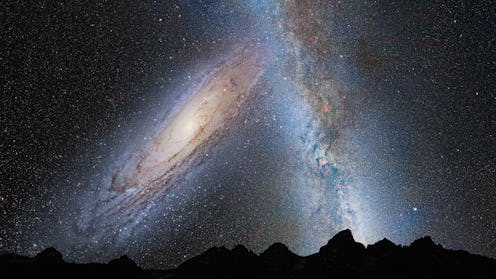Life
Could This Flickering Star Be Proof Of Aliens?

“KIC 8462852” is a rather sterile name for a star whose strange behavior has scientists stumped. Located 1,480 light years from Earth, the star has displayed a set of baffling dips in brightness since 2011, leading researchers to consider a wide variety of explanations — including that the star may be affected by structures built by an advanced alien civilization. To be clear, scientists are (sadly) not declaring KIC 8462852 to be proof of extraterrestrial life — but the fact that “alien megastructures” are even being considered as a possible explanation for the star’s behavior warms the cockles of my nerdy sci-fi-loving heart.
I want to prepare for our upcoming alien encounter as much as the next person, but let’s not get ahead of ourselves. Here’s the story: KIC 8462852’s weird light pattern was first monitored by NASA’s Kepler Space Telescope. Since 2009, Kepler has observed 150,000 stars, looking for small dips in brightness; these light fluctuations can be indications that a planet has passed in front of the star. According to Slate, this method has been used to discover thousands of planets that orbit stars other than our sun, called exoplanets.
In 2011, observers from Planet Hunters, a group of citizen scientists at Yale University, found that KIC 8462852 was acting strangely. The star’s light fluctuations were irregular and surprisingly extreme: For example, according to Slate, a planet the size of Jupiter (which is huge) would only block about one percent of the light emitted from this type of star, but, in one instance, the light of KIC 8462852 dipped by a whopping 22 percent. Yale postdoc Tabetha Boyajian told The Atlantic, “We’d never seen anything like this star. It was really weird. We thought it might be bad data or movement on the spacecraft, but everything checked out.”
In a recent paper about this phenomenon, Boyajian considers a variety of explanations for the star’s unusual dips in brightness, including that the results could be due to defects in equipment or a major collision with another object. None of these explanations proved satisfactory. A final theory suggests that the star could be orbited by a cluster of comets, but although this is the most plausible of the proposed explanations, even that doesn’t seem very likely. This is where the aliens come into it.
To be clear, Boyajian does not mention alien life anywhere in her research on KIC 8462852. This theory actually comes from a Penn State scholar Jason Wright, who told The Atlantic, “When [Boyajian] showed me the data, I was fascinated by how crazy it looked. Aliens should always be the very last hypothesis you consider, but this looked like something you would expect an alien civilization to build.” Wright and his colleagues have suggested that the star’s dips in brightness are “consistent with a ‘swarm of megastructures’” used as energy sources. These megastructures could form what’s known as a Dyson sphere, a giant theoretical structure hypothesized in 1960 by physicist Freeman Dyson. A Dyson sphere is a structure that surrounds a whole planet, collecting its energy, and thus acting as a huge power source. Watch Captain Jean-Luc Picard helpfully explain the concept:
Although the possibility of alien megastructures is an exciting hypothesis, it’s not necessarily (or even likely) true. Many are skeptical of the explanation; as Jeffrey Kluger writes in Time,
If you’ve got a half a dozen natural scenarios that you reject as implausible and then an additional one that requires giant light-concentrating spacecraft built by aliens, and that’s the one passes your plausibility test, well, you might not have evaluated the probabilities as carefully as you should have.
Research into the mystery of KIC 8462852 is ongoing. According to The Atlantic, Boyajian has teamed up with Wright and the Director of the SETI Research Center at UC Berkeley, Andrew Siemion, to create a proposal to analyze the star using a large radio dish, to “see if it emits radio waves at frequencies associated with technological activity.”